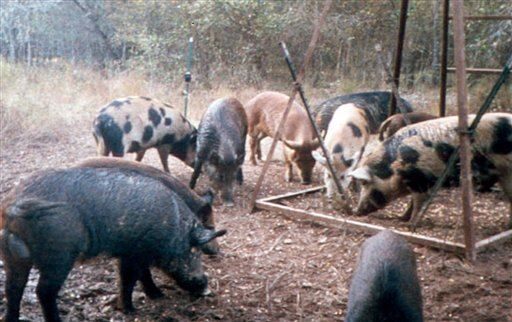There’s a ticking time bomb when it comes to wild hogs — and the billions in damage they cause.
There are about nine million feral hogs in the U.S. And those numbers are ballooning and increasing the estimated $2.5 billion in damage they already cost in the U.S. each year, the U.S. Department of Agriculture says.
That’s according to Dale Nolte, manager of the National Feral Swine Damage Management Program at the Department of Agriculture, who tells The Atlantic that the increasing numbers of feral hogs in the U.S. is sometimes referred to as a “ferral swine bomb.”
He says because they can reproduce so quickly, it’s very difficult to control the problem.
“To go from a thousand to two thousand, it’s not a big deal,” Nolte told The Atlantic. “But if you’ve got a million, it doesn’t take long to get to four [million], then eight million.”
Nolte says some feral hogs — domestic breeds and European wild boar — have cross-bred and become “what we’d call super-pigs.”
What does a “super-pig” look like?
According to Nolte, they’re highly intelligent, have very good senses of smell and have physical attributes, like heavy fur, which increase their ability to survive in the wild. This is what they inherit from boars.
Equally problematic is the qualities they get from domestic pigs, which have been bred to be fertile at all times and to have large litters, more than 10 piglets in each litter, on average.
Feral hogs are also able to grow very big — about 75 to 250 pounds on average, the Department of Agriculture says. But they can be twice that size and reach up to three feet in height.
“The problem with the hybrids is you get all of the massive benefits of all of that genetics,” says biologist Ryan Brook, of the University of Saskatchewan.
Hogs, according to Texas Parks and Wildlife, have four tusks that are constantly growing (two on top, two on bottom). They tend to be dark brown or black once they mature.
They can run up to 30 miles an hour.
Ham havoc
The Department of Agriculture explains the myriad ways feral hogs cause damage, saying it “affects everyone.”
A few of the areas affected by the invasive species are:
Food
Damage to crops when they eat or destroy field crops — sugar cane, corn, wheat, oats, rice and peanuts are frequent targets
Transmitting pathogens to healthy adult livestock and killing the young and vulnerable ones
Eating fruit, berries grapes and nuts from orchards and destroying the saplings when they rub plants with their bodies to get parasites off their skin
People and pets
Feral swine are known to carry at least 30 viral and bacterial diseases and nearly 40 parasites — all transmittable to to humans and pets
Organisms and pathogens that can be transmitted include swine flu, salmonella, hepatitis and pathogenic E. coli
Physical attacks — they’re known to have been aggressive toward farmers, hikers and picnickers. The department says aggression is increased when humans are associated with food because of handouts or improper waste disposal













